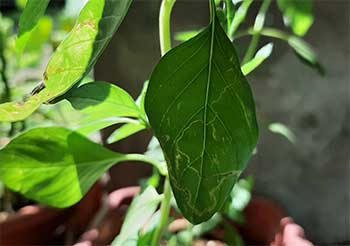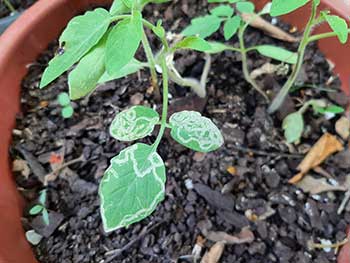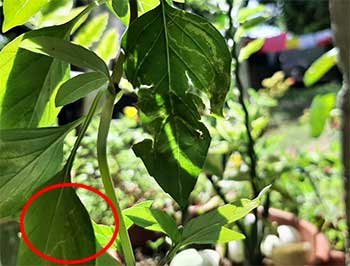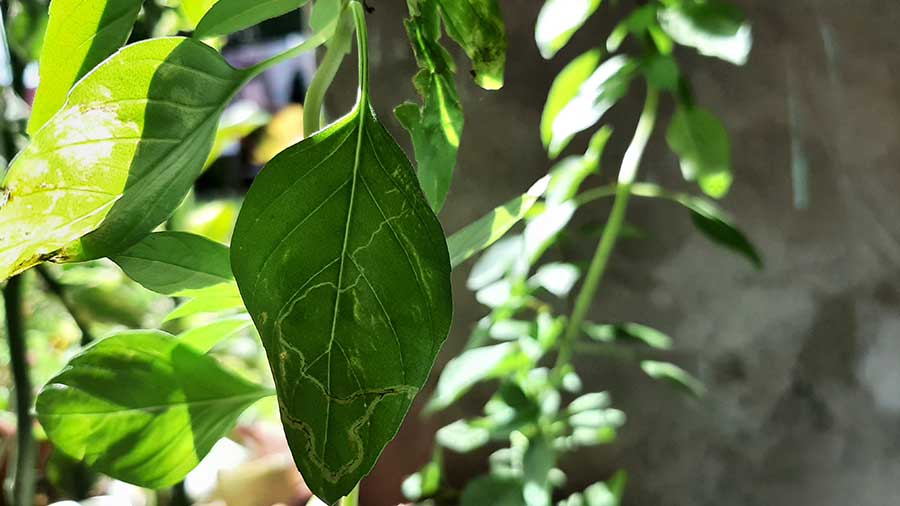Don’t you just hate it when one day, you see insects eating away at your plants’ leaves? This is exactly what happened to me. I have a few pots of basil plants in one corner of my garden. I wasn’t able to check on them for a week since I was busy with some school work.
When I finally went to water my basil, I was annoyed to see some distinctive leaf markings. The markings are light-brown to yellowish in color, which looks like a road map. I knew instantly that they were leaf miners. Leaf miners are the larvae of insects like moths, sawflies, and flies that feed on the soft tissues of leaves.
So how do you kill these pesky leaf miners? The quickest way to stop the spread of leaf miners is to simply pick off the leaves with the signs of infestation and throw them away. Another quick method is to rub the leaves with your fingers while squeezing them to kill the larvae. This is a suitable method when you are dealing with several affected leaves and you don’t want to pick them off. If the infestation persists, then you will have to apply pesticides. A good organic pesticide to kill leaf miners is a solution of liquid soap and pepper. Garlic and onion may also be added for better efficacy. Isolating the plant also helps in preventing the spread of leaf miners.

In the next section, I’m going to share with you my homemade, DIY recipes for an organic pesticide. Although, there are commercially available pesticides online such as Organic Neem Bliss, Monterey Garden Insect Spray, and Garden Safe Pest Control if you decide to buy one.
Cayenne Pepper Spray
100 grams of finely chopped hot pepper (or about 10 pieces cayenne)
1 liter of water
1 tablespoon liquid dishwashing soap
In a container, combine the chopped pepper, liquid soap, and water. Gently stir the mixture. Let the mixture steep for about 24 hours. To use, remove the solid particles by using a strainer. Pour the liquid into a spray applicator and use it as a foliage spray. Apply twice a week.

Garlic Repellant Spray
2 bulbs garlic
1 liter water
½ cup vegetable oil *if not available, you may use any cooking oil
1 tablespoon liquid soap
Chop the garlic into small pieces. Using a blender, mix the garlic in 1 liter of water. Let the mixture sit overnight. Afterward, remove the solid particles. I use a clean strainer to separate the liquid. Next, add in the vegetable oil and the liquid soap. Mix thoroughly.
To use, dilute the mixture in water. The dilution rate is 500 ml/liter of water. Spray once to twice a week. You can use the mixture for up to a month. Just keep it in a cool, dry area away from direct sunlight. Make sure to cover it tightly.
Chili Garlic Spray
2 bulbs garlic
1 bulb onion
100 grams chili (or cayenne pepper)
1 tablespoon liquid dishwashing soap
1 liter water
Blend the chili, garlic, and onion in 1 liter of water. Strain the mixture to remove solid particles. Add the liquid soap. Mix thoroughly. There’s no need to dilute this mixture, you can spray this immediately. Use on leafy plants only. Insects tend to avoid the smell of garlic, even the good ones, so don’t apply on flowering plants. Apply once or twice a week.
Vinegar Spray
1 tablespoon vinegar
1 tablespoon dishwashing liquid
1 liter water
Insects don’t like the acidity of the vinegar. At the same time, the vinegar acts as a preservative so the mixture will not spoil easily or produce an awful smell.
Put one tablespoon of vinegar in a 1-liter bottle of water. Next, add 1 tablespoon of the dishwashing liquid, or about 5 drops. Now, put the cap back on the water bottle and shake it well. After shaking it for about 1 minute, you can now transfer it to a sprayer Always remember to spray it in the late afternoon.
Never spray during noontime or in the morning. You can use this for any kind of plant. Spray once a week only. It may take about 3 applications for the pests to disappear.
What Makes Organic Pesticide Effective?
These homemade organic recipes are good for soft-bodied insects. These insects or their larvae destroy the plants by sucking plant sap or the soft tissues of the leaves. If not controlled early, they can cause stunted growth and deformed leaves. The acidity in the vinegar coats the insects’ exoskeleton which causes dehydration.

The acids in the soap can also remove the waxes protecting the insects’ skin which again leads to dehydration. I have written a more detailed article about how to get rid of bugs (insects, ants, snails, and slugs). You can read about it in this article.
Chili peppers contain capsaicin which is the main chemical that makes them hot to the taste. Capsaicin is a naturally-occurring biochemical pesticide. It is mainly used to kill insects and mites.
When spraying, make sure to spray on late afternoons to avoid extreme heat from the sun. The oils from organic materials may stick to the leaves and will cause the leaves to burn because of the extreme heat. It is also good to spray the underside of the leaves. You need to be sure that the insects or larvae are completely covered with the mixture.
The homemade recipes I have written here have a short residual action. Meaning, they lose their potency after a couple of days. To prevent the insects from coming back, be sure to spray at regular intervals (4-7 days) until they are completely gone. From my experience, it may take 3-4 applications.
Using Pest-Free Basil in the Culinary Arts
Basil is a tender, herbaceous plant with alternating broad, light green leaves. Because they come from the mint family, the light green to dark green and purple basil leaves look like peppermint. Because their leaves are so close together, the leaf miners could easily spread. There is an article I have written which talks more about basil. You may read it here.
Basil is a cornerstone of the culinary arts, used throughout the world for its fresh flavor. Fresh leaves taste sweet and peppery. This is the reason why I plant basil in my container garden. Most often, I make it into a pesto dressing, as basil gives out a delicious flavor.
You can also scatter over any tomato salad, especially one with mozzarella cheese. It is therefore important that whenever you use basil in your dishes, the leaves should be free from pests or parasites.










